U-Pb Zircon Age Constraints on the Paleozoic Sedimentation, Magmatism and Metamorphism of the Sredogriv Metamorphics, Western Balkan Zone, NW Bulgaria
Abstract
:1. Introduction
2. Geological Setting and Field Observations
3. Materials and Methods
4. Results
4.1. U-Pb Geochronology
4.2. Whole-Rock Geochemistry
5. Discussion
6. Conclusions
Supplementary Materials
Author Contributions
Funding
Data Availability Statement
Conflicts of Interest
References
- Haydoutov, I. Precambrian ophiolites, Cambrian Island arc and Variscan suture in the South Carpathian-Balkan region. Geology 1989, 17, 905–908. [Google Scholar] [CrossRef]
- Haydoutov, I.; Yanev, S. The Protomoesian microcontinent of the Balkan Peninsula- a peri-Gondwanaland piece. Tectonophysics 1997, 272, 303–313. [Google Scholar] [CrossRef]
- Haydoutov, I.; Pristavova, S.; Daieva, L.-A. Some features of Neoproterozoic-Cambrian geodynamics in Southeastern Europe. Comptes Rendus Academie Bulg. Sci. 2010, 63, 1597–1608. [Google Scholar]
- Žák, J.; Svojtka, M.; Gerdjikov, I.; Vangelov, D.A.; Kounov, A.; Sláma, J.; Kachlík, V. In search of the Rheic suture: Detrital zircon geochronology of Neoproterozoic to Lower Paleozoic metasedimentary units in the Balkan fold-and-thrust belt in Bulgaria. Gond. Res. 2023, 121, 196–214. [Google Scholar] [CrossRef]
- Savov, I.; Rayan, J.; Haydoutov, I.; Schijf, J. Late Precambrian Balkan-Carpathian ophiolite—A slice of Pan-African ocean crust? Geochemical and tectonic insights from the Tcherni Vrah and Deli Jovan massifs, Bulgaria and Serbia. J. Volcanol. Geotherm. Res. 2001, 110, 299–318. [Google Scholar] [CrossRef]
- Carrigan, C.; Mukasa, S.B.; Haydoutov, I.; Kolcheva, K. Neoproterozoic magmatism and Carboniferous high-grade metamorphism in the Sredna Gora Zone, Bulgaria: An extension of Gondwana-derived Avalonian-Cadomian belt? Prec. Res. 2006, 147, 404–416. [Google Scholar] [CrossRef]
- Carrigan, C.; Mukasa, S.; Haydoutov, I.; Kolcheva, K. Age of Variscan magmatism from the Balkan sector of the orogen, central Bulgaria. Lithos 2005, 82, 125–147. [Google Scholar] [CrossRef]
- Žák, J.; Svojtka, M.; Gerdjikov, I.; Ackerman, L.; Kachlík, V.; Sláma, J.; Vangelov, D.A.; Kounov, A. New U-Pb zircon ages from Cadomian basement of the Balkan fold-and-thrust belt of northern Bulgaria. Rev. Bulg. Geol. Soc. 2024, 85, 43–45. [Google Scholar] [CrossRef]
- Zagorchev, I. On the Early Paleozoic orogeneses in Bulgaria. Rev. Bulg. Geol. Soc. 2024, 85, 39–42. [Google Scholar] [CrossRef]
- Yanev, S. Paleozoic terranes of the Balkan Peninsula in the framework of Pangea assembly. Palaeogeogr. Palaeoclimatol. Palaeoecol. 2000, 161, 151–177. [Google Scholar] [CrossRef]
- Cortesogno, L.; Gaggero, L.; Ronchi, A.; Yanev, S. Late orogenic magmatism and sedimentation within Late Carboniferous to early Permian basins in the Balkan terrane (Bulgaria): Geodynamic implications. Int. J. Earth Sci. 2004, 93, 500–520. [Google Scholar] [CrossRef]
- Dyulgerov, M.; Ovtcharova-Schaltegger, M.; Ulianov, A.; Schaltegger, U. Timing of high-K alkaline magmatism in the Balkan segment of southeast European Variscan edifice: ID-TIMS and LA-ICP-MS study. Int. J. Earth Sci. 2018, 107, 1175–1192. [Google Scholar] [CrossRef]
- Georgiev, S.; Lazarova, A.; Balkanska, E.; Naydenov, K.; Broska, I.; Kurylo, S. Time constraints on the Variscan magmatism along Iskar River Gorge and Botevgrad basin, Bulgaria. Rev. Bulg. Geol. Soc. 2024, 85, 159–162. [Google Scholar] [CrossRef]
- Boncheva, I.; Lakova, I.; Sachanski, V.; Koenigshof, P. Devonian stratigraphy, correlations and basin development in the Balkan terrane, western Bulgaria. Gondwana Res. 2010, 17, 573–582. [Google Scholar] [CrossRef]
- Velichkova, S.H.; Handler, R.; Neubauer, F.; Ivanov, Z. Variscan to Alpine tectonothermal evolution of the Central Srednogorie unit, Bulgaria: Constraints from 40Ar/39Ar analysis. Swiss J. Geosci. Suppl. 2004, 84, 133–151. [Google Scholar]
- Angelov, V.; Antonov, M.; Gerdjikov, S.; Klimov, I.; Petrov, P.; Kiselinov, H.; Dobrev, G. Explanatory Note of Geological Map of Bulgaria, Scale 1:50,000, Sheet Rujinzi; Angelov, V., Chrischev, C., Eds.; Geocomplex: Sofia, Bulgaria, 2006; 107p, (In Bulgarian with English abstract). [Google Scholar]
- Angelov, V.; Antonov, M.; Gerdjikov, S.; Klimov, I.; Petrov, P.; Kiselinov, H.; Dobrev, G. Explanatory Note of Geological Map of Bulgaria, Scale 1:50,000, Sheets Knjazevats and Belogradchik; Angelov, V., Chrischev, C., Eds.; Geocomplex: Sofia, Bulgaria, 2006; 115p, (In Bulgarian with English abstract). [Google Scholar]
- Dabovski, C.H.; Zagorchev, I. Chapter 5.1. Introduction: Mesozoic evolution and alpine structure. In Geology of Bulgaria; Zagorchev, I., Dabovski, C., Nikolov, T., Eds.; Academic Publishing House “Marin Drinov”: Sofia, Bulgaria, 2009; Volume 5, part 2. Mesozoic geology; pp. 13–37, (In Bulgarian with English abstract). [Google Scholar]
- Ivanov, Z. Tectonics of Bulgaria; Sofia University Press: Sofia, Bulgaria, 2017; p. 331, (In Bulgarian with English abstract). [Google Scholar]
- Žák, J.; Svojtka, M.; Gerdjikov, I.; Kounov, A.; Vangelov, D.A. The Balkan terranes: A missing link between the eastern and western segments of the Avalonian-Cadomian orogenic belt? Int. Geol. Rev. 2022, 64, 2389–2415. [Google Scholar] [CrossRef]
- Dimitrov, S. Diabase rocks in Iskar gorge between the railroad station Bov and stop Lakatnik. Ann. Univ. Sofia Fac. Phys. Mat. Fac. 1929, 25, 175–273, (In Bulgarian with English abstract). [Google Scholar]
- Boyadjiev, S. On the diabase-phyllitoid complex in Bulgaria. Rev. Bulg. Geol. Soc. 1970, 31, 63–74, (In Bulgarian with English abstract). [Google Scholar]
- Ivanov, Z.; Kolcheva, K.; Moskovski, S.; Dimov, D. On the particularities and character of the “Diabase-Phyllitoid Formation”. Rev. Bulg. Geol. Soc. 1987, 48, 1–24, (In Bulgarian with French abstract). [Google Scholar]
- Kalvacheva, R. Palynology and stratigraphy of the Diabse-Phyllitoid complex in the West Balkan Mountains. Rev. Bulg. Geol. Soc. 1982, 33, 8–24, (In Russian with English abstract). [Google Scholar]
- Georgiev, S.; Popov, M.; Balkanska, E.; Gerdjikov, I.; Vangelov, D. First U-Pb zircon geochronology data of the diabases from the Lower Paleozoic section along Iskar and Gabrovnitsa River valleys. In Proceedings of the National Conference with International Participation “GEOSCIENCES 2016”, Sofia, Bulgaria, 7–8 December 2016; Bulgarian Geological Society: Sofia, Bulgaria, 2016; pp. 55–56. [Google Scholar]
- Haidutov, I.; Tenchov, Y.; Janev, S. Lithostratigraphic subdivision of the Diabase-Phyllitoid complex in the Berkovica Balkan Mountain. Geol. Balc. 1979, 9, 13–25, (In Bulgarian with English abstract). [Google Scholar]
- Haydoutov, I. Origin and Evolution of the Precambrian Balkan-Carpathian Ophiolitic Segment; Publishing House of the Bulgarian Academy of Sciences: Sofia, Bulgaria, 1991; 176p, (In Bulgarian with English abstract). [Google Scholar]
- Haydoutov, I.; Daieva, L.; Nedyalkova, S. Data on the composition and structure of the Stara Planina ophiolite association in Chiprovtsi region. Geotect. Tectonophys. Geodyn. 1985, 21, 14–25, (In Bulgarian with English abstract). [Google Scholar]
- Von Quadt, A.; Peytcheva, I.; Haydoutov, I. U-Pb dating of Tcherni Vrah metagabbro, West Balkan, Bulgaria. Comptes Rendus Academie Bulg. Sci. 1998, 51, 81–84. [Google Scholar]
- Kiselinov, H.; Georgiev, S.; Vangelov, D.; Gerdjikov, I.; Peytcheva, I. Early Devonian Carpathian-Balkan ophiolite formation: U–Pb zircon dating of Cherni Vrah gabbro, Western Balkan, Bulgaria. In Proceedings of the National Conference with International Participation “GEOSCIENCES 2017”, Sofia, Bulgaria, 7–8 December 2017; Bulgarian Geological Society: Sofia, Bulgaria, 2017; pp. 59–60. [Google Scholar]
- Zakariadze, G.; Karamata, S.; Korikovsky, S.; Ariskin, A.; Adamia, S.; Chkhotua, T.; Sergeev, S.; Solov’eva, N. The early-middle Paleozoic oceanic events along the southern European margin: The Deli Jovan ophiolite massif (NE Serbia) and paleo-oceanic zones of Great Caucasus. Turk. J. Earth Sci. 2012, 21, 635–668. [Google Scholar] [CrossRef]
- Balica, C.; Balintoni, I.; Berza, T. On the age of the Carpathian-Balkan pre-Alpine ophiolite in SW Romania, NE Serbia and NW Bulgaria. In Proceedings of the XX Congress of the Carpathian-Balkan Geological Association, Tirana, Albania, 24–26 September 2014; Buletini i Shkencave Gjeologjike, Special Issue 1. pp. 196–197. [Google Scholar]
- Plissart, G.; Monnier, C.; Diot, H.; Maruntiu, M.; Berger, J.; Triantafyllou, A. Petrology, geochemistry and Sm-Nd analyses on the Balkan-Carpathian Ophiolite (BCO–Romania, Serbia, Bulgaria): Remnants of a Devonian back-arc basin in the easternmost part of the Variscan domain. J. Geodyn. 2017, 105, 27–50. [Google Scholar] [CrossRef]
- Carrigan, C.; Mukasa, S.; Haydoutov, I.; Kolcheva, K. Ion microprobe U-Pb zircon ages of pre-Alpine rocks in the Balkan, Sredna Gora, and Rhodope terranes of Bulgaria: Constraints on Neoproterozoic and Variscan tectonic evolution. J. Czech. Geol. Soc. 2003, 48, 32–33. [Google Scholar]
- Moskovski, S.; Nedyalkova, S.; Harkovska, A.; Tenchov, Y.; Shopov, V.; Yanev, S. Stratigraphic and lithologic investigations in the core and part of the mantle of the Mihaylovgrad antcline between the rivers Chuprenska and Rikovska bara (Northwest Bulgaria). Trav. Sur La Géologie De Bulg. Ser. Stratigr. Tect. 1963, 5, 29–67, (In Bulgarian with English abstract). [Google Scholar]
- Kounov, A. Petrologic arguments for the assignment of the so-called Pesochnishka and Sredogrivska formations to the Diabase-Phyllitoid Formation. Rev. Bulg. Geol. Soc. 1973, 35, 203–207, (In Bulgarian with English abstract). [Google Scholar]
- Bonchev, S. Geology of the Western Stara Planina. II. The main lines of geological structure of the Western Stara Planina. Tr. Na Bulg. Pririodno Drujestvo 1910, 4, 1–59. (In Bulgarian) [Google Scholar]
- Haydoutov, I. Notes on the tectonomagmatic evolution of the and evolution of the Stara Planina eugeosyncline during the Phanerozoic. Bull. Geol. Inst. Ser. Geotect. 1973, 21, 5–20, (In Bulgarian with English abstract). [Google Scholar]
- Kiselinov, H. Tectonic Structure and Evolution of the Sredogriv Metamorphics. Ph.D. Thesis, Geological Institute Strashimir Dimitrov, Sofia, Bulgaria, 2011; 215p. (In Bulgarian). [Google Scholar]
- Kiselinov, H. Evolution of the Paleozoic (Silurian-Devonian?) Sredogriv metamorphics, NW Bulgaria. Geol. Balc. 2024, 53, 77–83. [Google Scholar] [CrossRef]
- Kiselinov, H.; von Quadt, A.; Peytcheva, I.; Pristavova, S. U-Pb dating and field relationships of the Protopopintsi metagranite with the Sredogriv metamorphites (NW Bulgaria). Compt. Rend. Acad. Bulg. Sci. 2009, 62, 1571–1580. [Google Scholar]
- Haydoutov, I.; Pristavova, S.; Daieva, L.-A. Late Neoproterozoic-Early Paleozoic Evolution of the Balkan Terrane (SE Europe)–a Probable Fragment of the Iapetus Ocean; Bulgarian Academy of Sciences: Sofia, Bulgaria, 2012; 132p, (In Bulgarian with English abstract). [Google Scholar]
- Jackson, S.E.; Pearson, N.J.; Griffin, W.L.; Belousova, E.A. The application of laser ablation-inductively coupled plasma-mass spectrometry to in situ U–Pb zircon geochronology. Chem. Geol. 2004, 211, 47–69. [Google Scholar] [CrossRef]
- Sláma, J.; Košler, J.; Condon, D.J.; Crowley, J.L.; Gerdes, A.; Hanchar, J.M.; Whitehouse, M.J. Plešovice zircon—A new natural reference material for U–Pb and Hf isotopic microanalysis. Chem. Geol. 2008, 249, 1–35. [Google Scholar] [CrossRef]
- Wiedenbeck, M.; Alle, P.; Corfu, F.; Griffin, W.; Meier, M.; Oberli, F.; Quadt, A.V.; Roddick, J.; Spiegel, W. Three natural zircon standards for U-Th-Pb, Lu-Hf, trace element and REE analyses. Geost. Newslett. 1995, 19, 1–23. [Google Scholar] [CrossRef]
- Paton, C.; Hellstrom, J.; Paul, B.; Woodhead, J.; Hergt, J. Iolite: Freeware for the visualization and processing of mass spectrometric data. J. Anal. At. Spectr. 2011, 26, 2508–2518. [Google Scholar] [CrossRef]
- Ludwig, K.R. User’s Manual for Isoplot/Ex, Version 4.15. A Geochronological Toolkit for Microsoft Excel; No. 4; Berkeley Geochronology Center Special Publication: Berkeley, CA, USA, 2011. [Google Scholar]
- Rubatto, D. Zircon trace element geochemistry: Partitioning with garnet and the link between U-Pb ages and metamorphism. Chem. Geol. 2002, 184, 123–138. [Google Scholar] [CrossRef]
- Tiepel, U.; Eichhorn, R.; Loth, G.; Rohrmülle, J.; Höll, R.; Kennedy, A. U-Pb SHRIMP and Nd isotopic data from the western Bohemian Massif (Bayerischer Wald, Germany): Implications for Upper Vendian and Lower Ordovician magmatism. Int. J. Earth Sci. 2004, 93, 782–801. [Google Scholar] [CrossRef]
- Taylor, S.R.; McLennan, S.M. The Continental Crust: Its Composition and Evolution; Blackwell: Oxford, UK, 1985; p. 312. [Google Scholar] [CrossRef]
- Pettijohn, F.J.; Potter, P.E.; Siever, R. Sand and Sandstone; Springer: Berlin/Heidelberg, Germany, 1972; p. 553. [Google Scholar]
- Roser, B.P.; Korsch, R.J. Provenance signatures of sandstone-mudstone suites determined using determiantion function analysis of major element data. Chem. Geol. 1988, 67, 119–139. [Google Scholar] [CrossRef]
- Floyd, P.A.; Leveridge, B.E. Tectonic environment of Devonian Gramscatho basin, south Cornwell: Framework mode and geochemical evidence from turbiditic sandstones. J. Geol. Soc. London. 1987, 144, 531–542. [Google Scholar] [CrossRef]
- Nesbitt, H.W.; Young, G.M. Prediction of some weathering trends of plutonic and volcanic rocks based on thermodynamic and kinetic considerations. Geochim. Cosmochim. Acta 1984, 48, 1523–1534. [Google Scholar] [CrossRef]
- McLennan, S.M.; Hemming, S.; McDaniel, D.K.; Hanson, G.N. Geochemical approaches to sedimentation, provenance and tectonics. In Processes Controlling the Composition of Clastic Sediments; Johnson, M.J., Basu, A., Eds.; Geological Society of America: London, UK, 1993; Volume 284, pp. 21–40. [Google Scholar] [CrossRef]
- Bhatia, M.R.; Crook, K.A.W. Trace element charcteristics of graywackes and tectonic setting discrimination of sedimentary basins. Contrib. Minaral. Petrol. 1986, 92, 181–193. [Google Scholar] [CrossRef]
- Filipov, P.; Bonev, N.; Vladinova, T.; Kalchev, R.; Georgiev, S.; Macheva, L.; Georgieva, H.; Vlahov, A.; Morin, G. U-Pb detrital zircon geochronology of the late Paleozoic-early Mesozoic sedimentary successions from the Belogradchik Unit in the West Fore-Balkan, NW Bulgaria. Rev. Bulg. Geol. Soc. 2024, 85, 155–158. [Google Scholar] [CrossRef]
- Matte, P. Tectonics and plate tectonics model for the Variscan belt in Europe. Tectonophysics 1986, 126, 329–374. [Google Scholar] [CrossRef]
- Franke, W. The mid-European segment of the Variscides: Tectonostratigraphic units, terrane boundaries and plate tectonic evolution. In Orogenic Processes: Quantification and Modelling the Variscan Belt; Franke, W., Haak, V., Oncken, O., Tanner, D., Eds.; Geological Society, Special Publication: London, UK, 2000; Volume 179, pp. 35–61. [Google Scholar]
- von Raumer, J.F.; Stampfli, G.M.; Busy, F. Gondwana-derived microcontinents–the constituents of Variscan and Alpine collisional orogens. Tectonophysics 2003, 365, 7–22. [Google Scholar] [CrossRef]
- Stampfli, G.M.; Kozur, H.W. Europe from the Variscan to the Alpine cycles. In European Lithosphere Dynamics; Gee, D.G., Stephenson, R.A., Eds.; Geological Society, Memoirs: London, UK, 2000; Volume 32, pp. 57–82. [Google Scholar]
- Kroner, U.; Romer, R.L. Two plates-Many subduction zones: The Variscan orogeny reconsidered. Gond. Res. 2013, 24, 298–329. [Google Scholar] [CrossRef]
- Stephan, T.; Kroner, U.; Romer, R.L.; Rösel, D. From a bipartite Gondwanan shelf to an arcuate Variscan belt: The early Paleozoic evolution of northern peri-Gondwana. Earth Sci. Rev. 2019, 192, 491–512. [Google Scholar] [CrossRef]
- Okay, A.I.; Topuz, G. Variscan orogeny in the Black Sea region. Int. J. Earth Sci. 2017, 106, 569–592. [Google Scholar] [CrossRef]
- Okay, A.I.; Nikishin, A.M. Tectonic evolution of the southern margin of Laurasia in the Black Sea region. Int. Geol. Rev. 2015, 57, 1051–1076. [Google Scholar] [CrossRef]
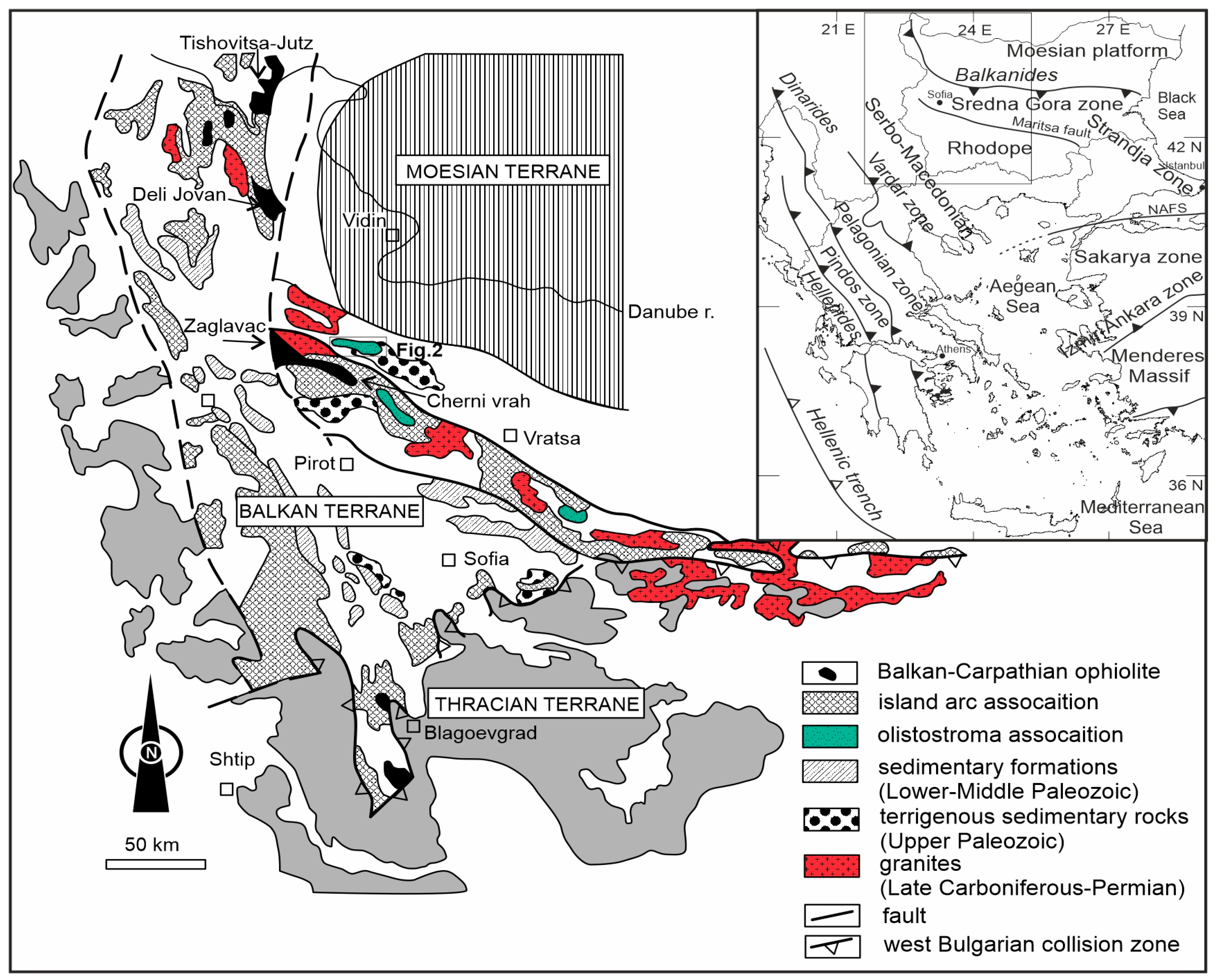

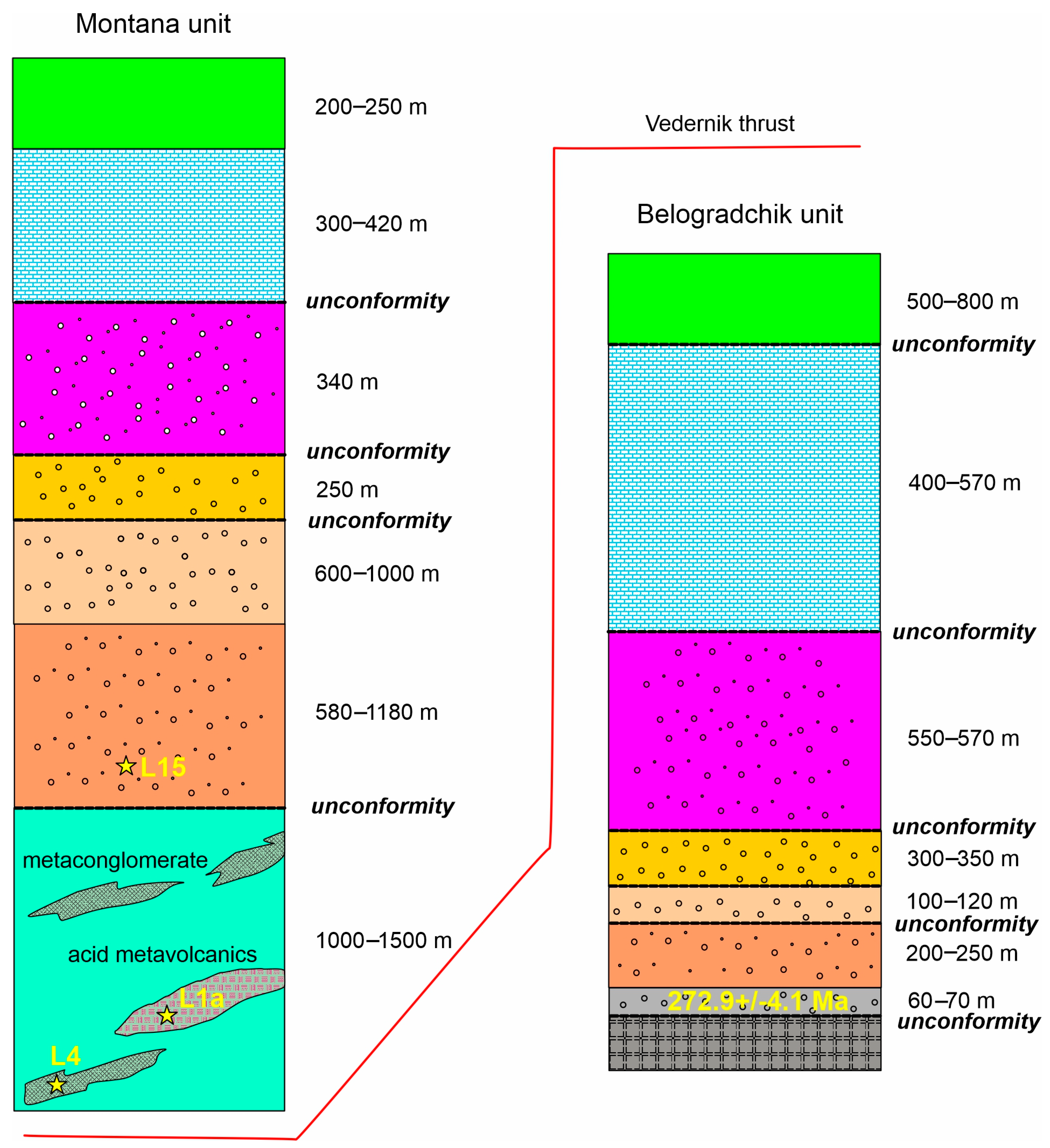
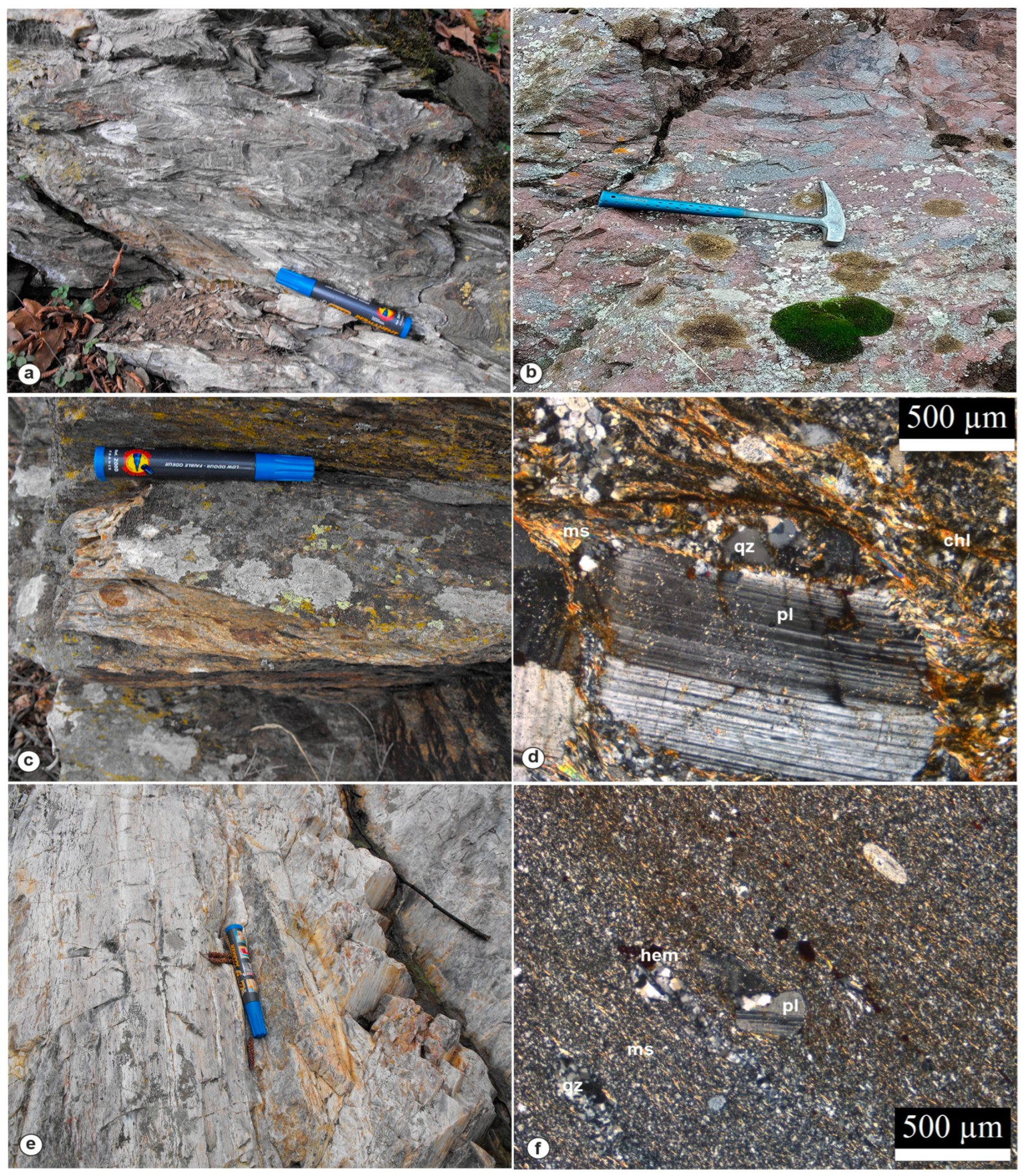

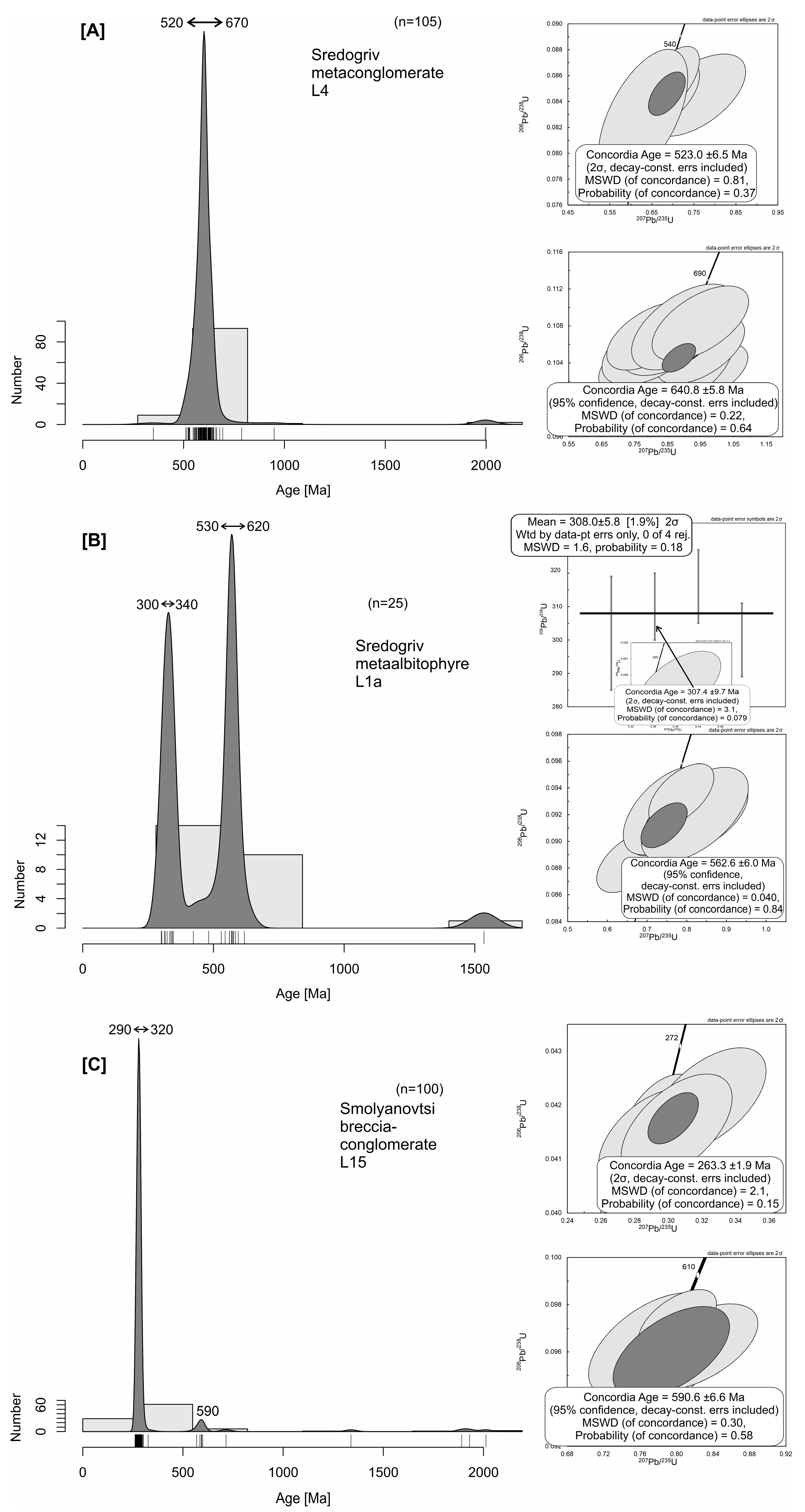
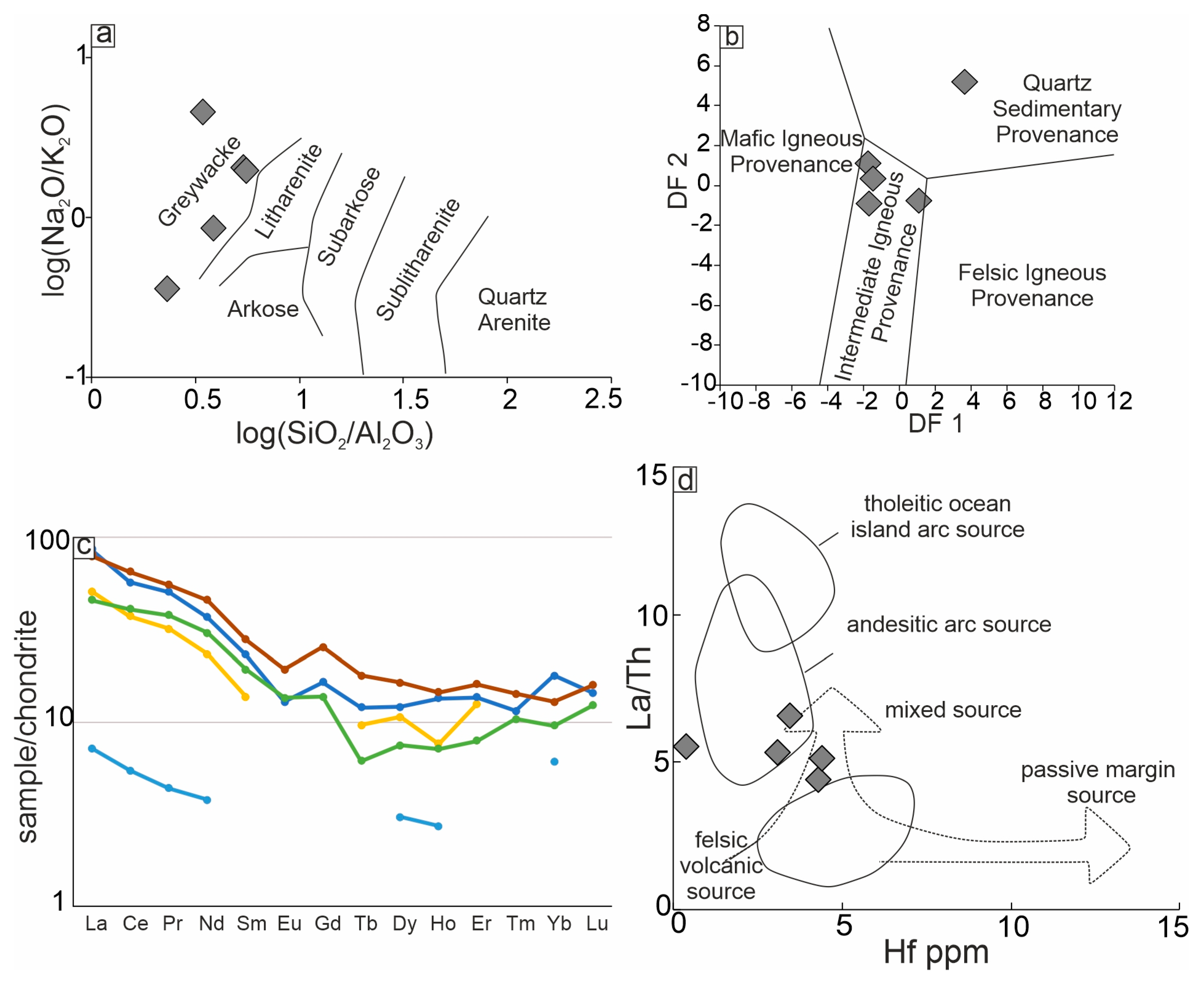
Disclaimer/Publisher’s Note: The statements, opinions and data contained in all publications are solely those of the individual author(s) and contributor(s) and not of MDPI and/or the editor(s). MDPI and/or the editor(s) disclaim responsibility for any injury to people or property resulting from any ideas, methods, instructions or products referred to in the content. |
© 2025 by the authors. Licensee MDPI, Basel, Switzerland. This article is an open access article distributed under the terms and conditions of the Creative Commons Attribution (CC BY) license (https://creativecommons.org/licenses/by/4.0/).
Share and Cite
Bonev, N.; Filipov, P.; Vladinova, T.; Stoylkova, T.; Georgieva, H.; Georgiev, S.; Kiselinov, H.; Macheva, L. U-Pb Zircon Age Constraints on the Paleozoic Sedimentation, Magmatism and Metamorphism of the Sredogriv Metamorphics, Western Balkan Zone, NW Bulgaria. Geosciences 2025, 15, 148. https://doi.org/10.3390/geosciences15040148
Bonev N, Filipov P, Vladinova T, Stoylkova T, Georgieva H, Georgiev S, Kiselinov H, Macheva L. U-Pb Zircon Age Constraints on the Paleozoic Sedimentation, Magmatism and Metamorphism of the Sredogriv Metamorphics, Western Balkan Zone, NW Bulgaria. Geosciences. 2025; 15(4):148. https://doi.org/10.3390/geosciences15040148
Chicago/Turabian StyleBonev, Nikolay, Petyo Filipov, Tsvetomila Vladinova, Tanya Stoylkova, Hristiana Georgieva, Svetoslav Georgiev, Hristo Kiselinov, and Lyubomirka Macheva. 2025. "U-Pb Zircon Age Constraints on the Paleozoic Sedimentation, Magmatism and Metamorphism of the Sredogriv Metamorphics, Western Balkan Zone, NW Bulgaria" Geosciences 15, no. 4: 148. https://doi.org/10.3390/geosciences15040148
APA StyleBonev, N., Filipov, P., Vladinova, T., Stoylkova, T., Georgieva, H., Georgiev, S., Kiselinov, H., & Macheva, L. (2025). U-Pb Zircon Age Constraints on the Paleozoic Sedimentation, Magmatism and Metamorphism of the Sredogriv Metamorphics, Western Balkan Zone, NW Bulgaria. Geosciences, 15(4), 148. https://doi.org/10.3390/geosciences15040148





